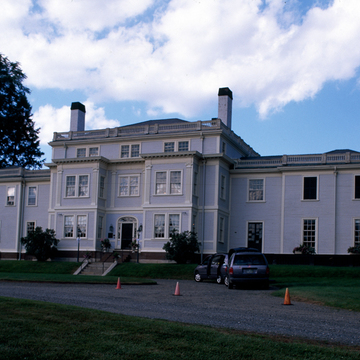The Lyman Estate, a distinguished example of a gentleman's country seat of the late eighteenth century, is significant for its architect, Samuel McIntire, and for its early landscape gardening laid out by English-trained gardener William Bell in the picturesque style. The property also contains the earliest surviving greenhouses in the region (1800, 1804). Theodore Lyman, successful merchant in the China trade, commissioned the clap-boarded five-part Federal-style design in 1793, though the right-hand wing was not completed immediately. In his 1822 Encyclopedia of Landscape Gardening, J. C. Loudon described the Vale as “one of the most beautiful and artistically arranged estates in the country,” notable for its specimen plantings such as the giant copper beech. In 1882 the Lymans added an upper story and remodeled the interior in keeping with Victorian taste, though they kept the two most significant McIntire spaces, the oval parlor and the ballroom, intact. In 1917, architect Nina Tupper “recolonialized” the other major rooms.
You are here
The Vale, Lyman Estate
1793, Samuel McIntire; 1882, Hartwell, Richardson and Driver; 1917, Nina Tupper. 185 Lyman St.
If SAH Archipedia has been useful to you, please consider supporting it.
SAH Archipedia tells the story of the United States through its buildings, landscapes, and cities. This freely available resource empowers the public with authoritative knowledge that deepens their understanding and appreciation of the built environment. But the Society of Architectural Historians, which created SAH Archipedia with University of Virginia Press, needs your support to maintain the high-caliber research, writing, photography, cartography, editing, design, and programming that make SAH Archipedia a trusted online resource available to all who value the history of place, heritage tourism, and learning.


